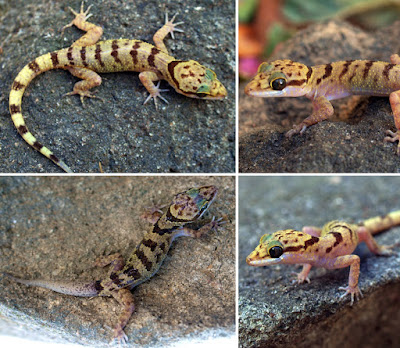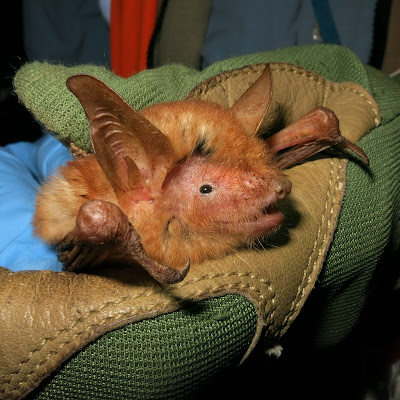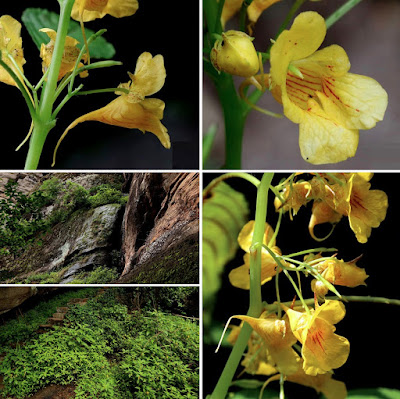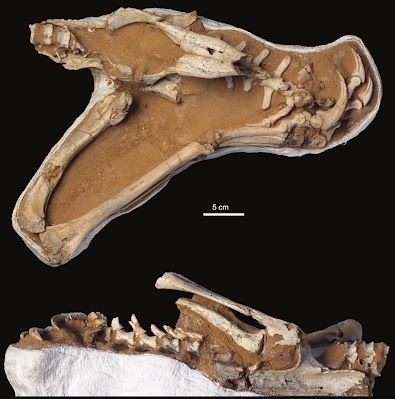[Most Recent Entries] [Calendar View]
Thursday, January 14th, 2021
| Time | Event | ||||||||
| 10:33a | [Herpetology • 2021] Cyrtodactylus chungi • A New Cyrtodactylus (Squamata: Gekkonidae) from Binh Thuan Province, southern Vietnam
ABSTRACT We describe a new species of Cyrtodactylus on the basis of two specimens collected from Ta Kou Nature Reserve, Binh Thuan Province, southern Vietnam. Cyrtodactylus chungi sp. nov. is distinguished from the remaining Indochinese bent-toed geckos by a combination of the following characters: relatively small body size (SVL up to 68.5 mm); a continuous neckband; 5 or 6 irregular transverse dorsal bands; 11 or 12 bands on original tail; keeled tubercles present on dorsum, posterior limbs and tail; 17 or 18 irregular dorsal tubercle rows; 30 or 31 ventral scale rows; ventrolateral skin folds indistinct; an angular series of seven precloacal pores in male and six pitted, enlarged precloacal scales in female, each series separated by a diastema of undifferentiated scales from 4–6 enlarged, poreless femoral scales; median subcaudals slightly enlarged; 17–20 subdigital lamellae under the fourth toe. Based on molecular analyses of the fragment of mitochondrial gene cytochrome c oxidase subunit I (COI), the new species is recovered as the sister taxon to Cyrtodactylus cattienensis s. str. with a genetic divergence of more than 9%. In phylogenetic analyses, the new species is recovered as a member of the Cyrtodactylus irregularis species group. Keywords: Cyrtodactylus chungi sp. nov., molecular phylogeny, taxonomy, Ta Kou Mountain, COI gene Class Reptilia Laurenti, 1768 Order Squamata Oppel, 1811 Family Gekkonidae Gray, 1825 Subfamily Gekkoninae Gray, 1825 Genus Cyrtodactylus Gray, 1827
Cyrtodactylus chungi sp. nov. Diagnosis: The new species can be distinguished from other members of the genus Cyrtodactylus by a combination of the following characters (Table 1): relatively small body size (SVL up to 68.5 mm); a continuous neckband; 5 or 6 irregular transverse dorsal bands; 11 or 12 bands on original tail; keeled tubercles present on dorsum, posterior limbs and tail; 17 or 18 irregular dorsal tubercle rows; 30 or 31 ventral scale rows; ventrolateral skin folds indistinct; an angular series of seven precloacal pores in male and six pitted, enlarged precloacal scales in female, each series separated by a diastema of undifferentiated scales from 4–6 enlarged, poreless femoral scales; median subcaudals slightly enlarged; 17–20 subdigital lamellae under the fourth toe. Etymology: Specific epithet ‘chungi’ is in honor of Prof. Dr Ngo Dac Chung, College of Education, Hue University, in recognition of his outstanding contributions to training of many herpetologist generations from Hue University. For the common names we suggest Chung’s Bent-toed Gecko (English) and Thạch sùng ngón chứng (Vietnamese). Distribution: Cyrtodactylus chungi sp. nov.is currently known only from the type locality in Ta Kou Nature Reserve, Binh Thuan Province, Vietnam.
Sabrina Ostrowski, Minh Duc Le, Hanh Thi Ngo, Cuong The Pham, Trung My Phung, Truong Quang Nguyen and Thomas Ziegler. 2021. A New Cyrtodactylus (Squamata: Gekkonidae) from Binh Thuan Province, southern Vietnam. European Journal of Taxonomy. 731(1), 47-70. DOI: 10.5852/ejt.2021.731.1203 | ||||||||
| 10:41a | [Mammalogy • 2021] Myotis nimbaensis • A New Dichromatic Species of Myotis (Chiroptera: Vespertilionidae) from the Nimba Mountains, Guinea
Abstract SYSTEMATICS Family Vespertilionidae Gray, 1821 Subfamily Myotinae Tate 1942 Genus Myotis Kaup, 1829 Subgenus Chrysopteron Jentink, 1910 Myotis nimbaensis, new species Nimba Myotis Etymology: Myotis nimbaensis (“from Nimba”) is named in recognition of the mountain range in which it was discovered. As an epithet referring to a place, nimbaensis is spelled the same way whether applied in combination with either a masculine or a feminine genus name. Woodman (1993) argued that Myotis should be considered feminine in gender, but Pritchard (1994) disagreed. Both of these authors overlooked a 1958 ruling by the International Commission on Zoological Nomenclature that fixed the gender of Myotis as masculine and placed the name as such on the Official List of Generic Names in Zoology (International Commission on Zoological Nomenclature, 1958). So in this case, nimbaensis is masculine. Distribution: Known only from the type locality and vicinity in the Guinean Nimba Mountains. Nancy B. Simmons, Jon Flanders, Eric Moïse Bakwo Fils, Guy Parker, Jamison D. Suter, Seinan Bamba, Mory Douno, Mamady Kobele Keita, Ariadna E. Morales and Winifred F. Frick. 2021. A New Dichromatic Species of Myotis (Chiroptera: Vespertilionidae) from the Nimba Mountains, Guinea. American Museum Novitates. 3963. digitallibrary.AMNH.org/handle/2246/7249 | ||||||||
| 3:04p | [Botany • 2020] Impatiens wuyiensis (Balsaminaceae) • A New Species from Fujian of Southeast China, based on Morphological and Molecular Evidences
Abstract Background: Southeast Asia, together with tropical Africa, Madagascar, South India and Sri Lanka, and the eastern Himalayas, are the five primary hotspots of species diversity of Impatiens (Balsaminaceae). China is also rich in Impatiens species, especially in the limestone karsts or ‘Danxia’ landforms. With zygomorphic flowers and diverse corolla morphology and color, the species in Impatiens are well-known for their ornamental use, but they are also notorious in taxonomy. During the preparation of revision of Impatiens in Zhejiang and adjacent regions, an unknown species was collected from Mt. Wuyi in Fujian Province, Southeast China. Results: Phylogenetic analyses based on nuclear ITS, chloroplast atpB-rbcL and trnL-F sequences, together with micromorphology of pollen grains and seed coats, strongly supported the close relationship of the new species with Impatiens platysepala Y.L.Chen and I. chloroxantha Y.L.Chen. In turn, both molecular data and morphological characters also were sufficient to distinguish the new species from the other two counterparts. Conclusions: Our detailed morphological observations and molecular phylogenetic analyses support the recognition of Impatiens wuyiensis as a species new to science. Keywords: Danxia landform, Flora of Southeast China, Impatiens wuyiensis, Sect. Impatiens, Taxonomy Impatiens wuyiensis J.S.Wang, Y.F.Lu & X.F.Jin, sp. nov.: 武夷凤仙花 Diagnosis: Haec species in characteribus floralibus est affinis Impatienti platysepalae Y.L. Chen et I. chloroxanthae Y.L. Chen, a qua floribus luteis, sepalis lateralibus dense purpureo-rubro-maculatis, costas vexilli dorso in medio breviter clavatis vel cornutis, bracteis herbaceis linearis vel anguste ovato-lanceolatis, 3–4 mm longis, ca. 0.5 mm latis differt. Distribution, habitat and ecology: Impatiens wuyiensis seems to be restricted to Mt. Wuyi. It is widely distributed along several scenic spots, such as Dawangfeng, Tianyoufeng, Shuiliandong and Lianhuafeng views. It grows in moist places by roadside or in grasslands, on rock face, under forest or at forest margins, at an elevation between 220 and 430 m (Fig. 5: a, b). Etymology: The specific epithet ‘wuyiensis’ is derived from the type locality, Mt. Wuyi, northern Fujian Province. Jian-Sheng Wang, Yi-Fei Lu, Yue-Liang Xu, Shui-Hu Jin and Xiao-Feng Jin. 2020. Impatiens wuyiensis (Balsaminaceae), A New Species from Fujian of Southeast China, based on Morphological and Molecular Evidences. Botanical Studies. 61: 29. DOI: 10.1186/s40529-020-00306-1 | ||||||||
| 3:33p | [Paleontology • 2021] Shri devi • A New Dromaeosaurid (Dinosauria: Theropoda) from the Late Cretaceous Khulsan Locality of Mongolia
Abstract A new dromaeosaurid dinosaur, Shri devi, from the Late Cretaceous deposit of the Barun Goyot Formation at Khulsan, Mongolia, is described here. The Barun Goyot Formation (herein referred to as the Barun Goyot) is stratigraphically intermediate between the overlying Nemegt Formation and the underlying Djadokhta Formation, where much of the dromaeosaurid diversity has been reported to date. Sediments of the Barun Goyot are typically considered Upper Campanian in age. Although dromaeosaurid remains have been noted to occur in the Barun Goyot for decades, descriptive and taxonomic work has never been completed for the material. The holotype specimen (IGM 100/980) consists of a partially articulated individual preserving the right hind limb; left tibiotarsus; pelvis; and adjacent cervical, dorsal, and caudal vertebrae. IGM 100/980 is referable to a clade with Velociraptor based on the presence of a distinct ambiens tubercle located proximally on the anterior face of the pubis, a well-developed anterior tuberosity proximally located on the ischium, and a rounded longitudinal ischial ridge. It is distinguishable from Velociraptor mongoliensis based on a weak fourth trochanter (shared with all other dromaeosaurids) and deep anterior pedicular fossae in the cervical vertebrae; epipophyses in the last four cervicals are not raised but are instead represented by rugose circular scars. A suite of axial and appendicular characters are diagnostic for the new species. New discoveries including Shri devi allow for an improved understanding of dromaeosaurid anatomy, as well as the temporal and regional variation of the dromaeosaurid fauna of Mongolia and Inner Mongolia (Nei Mongol Autonomous Region, China), during the Late Cretaceous.
SYSTEMATIC PALEONTOLOGY THEROPODA MARSH, 1884 COELUROSAURIA VON HUENE, 1914 MANIRAPTORA GAUTHIER, 1986 DROMAEOSAURIDAE MATTHEW AND BROWN, 1922 Shri devi, new genus, new species Etymology: “Shri Devi,” Sanskrit for a female protector deity in Tibetan/Mongolian Buddhism. Part of the Gelug tradition and particularly venerated in Mongolia, Shri Devi (Palden Lhamo) rides a horse or donkey across an ocean of blood. Her accoutrements include a saddle of a flayed human skin, the book of the law, and the dice of fortune. Formation and Locality: Bayun Goyot Formation, Khulsan, Ömnögov, Mongolia. No complete section for the Barun Goyot Formation at Khulsan has been constructed. What can be said is that IGM 100/980 is composed of the type of sediments present at other Djadoktha (Ukhaa Tolgod, Udan Sayr, and Bayn Dzak) and Djadoktha-like (Red Beds of Kheerman Tsav, Bayan Mandahu and Khulsan) localities. These are considered to be a mélange of aeolian, debris flow, fluvial, and lacustrine sediments. The environment of these sediments at time of deposition is considered to be an arid to semiarid region, with an equable climate (Dingus et al., 2008, Montanari et al., 2013). Diagnosis: Referable to a clade including Velociraptor based on the presence of a distinct ambiens tubercle located proximally on the anterior face of the pubis, a well-developed anterior tuberosity proximally located on the ischium, and a rounded longitudinal ischial ridge. Distinguishable from Velociraptor mongoliensis based on a weak fourth trochanter (shared with all other dromaeosaurids), deep anterior pedicular fossae in the cervical vertebrae, epipophyses in the last four are not raised but instead represented by rugose circular scars. Shri devi is furthered diagnosed by the following combination of characters (asterisks denote autapomorphies): epipophysis on the first dorsal vertebra (d1) large and overhanging the posterior margin of the postzygapophysis*; two dorsoventrally aligned pleurocoels on d1 and d2*; posteriorly inclined scar on the lateral surface of the neural arch*; proportionally longer metatarsus (44% femur length compared to 35% femur length in IGM 100/986), and proportionally larger ungual phalanx on pedal digit 2 (1.01% MT II length compared to 90% MT II length in IGM 100/982 and IGM 100/985).
Alan H. Turner, Shaena Montanari and Mark A. Norell. 2021. A New Dromaeosaurid from the Late Cretaceous Khulsan Locality of Mongolia. American Museum Novitates. 2020; 1-48. DOI: 10.1206/3965.1 digitallibrary.AMNH.org/handle/2246/7251 |
| << Previous Day |
2021/01/14 [Calendar] |
Next Day >> |

















